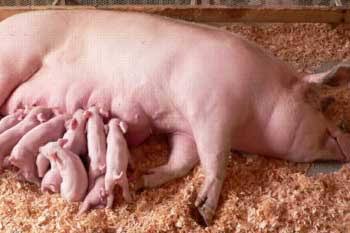10 Steps To Successful Farrowing
1. Prepare farrowing rooms.
 Learn More
Learn MoreEnsure rooms are warm enough and controls are reset for newly farrowed pigs.
Ensure hot boxes are cleaned, dried and disinfected and drying agents are available.
Ensure heat lamps are working and adjusted to proper location (at the rear of the crate over the mat) and height to achieve 95°F. temperature on the surface of the mat.
2. Ensure mats are in place.
Ensure the tote is ready with farrowing supplies (oxytocin, sleeves, lube, etc.)
Ensure the room is quiet.
3. Make sure sows are ready to farrow.
Guarantee correct sow condition (18-19 mm/0.70-0.74 in. backfat).
Guarantee vaccinations are done according to the sow farm vaccination schedule.
Guarantee sows are fed 4 lb./day starting at Day 112 of gestation.
4. Evaluate environment daily.
Ensure room temperature is 72-75° F.
Ensure pigs are laid out (not piling) under heat lamps.
Ensure pig comfort by watching and listening to the pigs.
Ensure total airflow is not too high (20 cfm/sow) and ventilation is adjusted properly to avoid drafts and chilling pigs.
5. Induce sows with care.
Make use of induction to attend farrowings of sows with problem histories.
Avoid inducing sows too early (no less than Day 114 of gestation), which can lead to low-viability pigs.
6. Work to reduce stillbirths.
Understand what leads to increased stillbirths and mark animals for the following: high parity, overconditioning, unattended farrowings, misuse of oxytocin (overdosing, volume and frequency) and a history of stillbirths.
Intervene if the sow has had a stillbirth, has trouble farrowing or has gone more than 20-30 minutes without farrowing a live pig.
Realize these could have been profitable pigs.
7. Warm up and dry off all piglets.
Realize pigs are born wet and cold.
Use hot boxes and drying powder.
Ensure all pigs receive a good dose of colostrum.
Realize all pigs need colostrum.
Realize colostrum provides warmth, energy and important antibodies.
Observe the piglets in the afternoon after farrowing to make sure all piglets got a good drink. Mark the heads of pigs to make sure they have nursed.
Split suckle all litters to make sure piglets get off to a good start.
8. Minimize transfers.
Realize piglets may need to be moved to divide up the number of piglets on a sow without concern for size.
Transfer pigs with minimal movement.
Don’t disrupt litters if you don’t have to. Unnecessary disruption leads to lay-ons.
READ ALSO: General Guide To Pig Nutrition & Feeding
9. Don’t ignore fallbacks or starveouts.
Give these pigs attention everyday.
Observe all the piglets and identify opportunity animals daily, then provide a better place for those pigs in need.
Use empty crates, nurse sows, bump weaning, etc., to meet the needs of compromised pigs.
READ ALSO: FIVE SWINE PRODUCTION FARROWING MANAGEMENT TIPS
10. Evaluate the sow.
Make this job easy.
Judge whether sows are eating.
Empty feeders and provide fresh feed.
Check water flow and help first-parity females find water.
Determine if sows are passing manure.
Evaluate for health concerns such as udder edema or a retained pig.
Evaluate whether pigs look good.
Determine if all of these areas have been covered. If so, then move on. If not, then provide attention to detail and work to fix the sow. Walk the sow so she will urinate and defecate, which should stimulate appetite.















